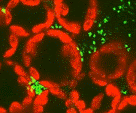Plant Pathology Department
Date of this Version
2015
Citation
Stewart, C. L., Pyle, J. D., Jochum, C. C., Vogel, K. P., Yuen, G. Y., and Scholthof, K.-B. G. 2015. Multi-year pathogen survey of biofuel switchgrass breeding plots reveals high prevalence of infections by Panicum mosaic virus and its satellite virus. Phytopathology 105:1146-1154.
Abstract
Switchgrass (Panicum virgatum) cultivars are currently under development as lignocellulosic feedstock. Here we present a survey of three established switchgrass experimental nurseries in Nebraska in which we identified Panicum mosaic virus (PMV) as the most prevalent virus. In 2012, 72% of 139 symptomatic plants tested positive for PMV. Of the PMV-positive samples, 19% were coinfected with its satellite virus (SPMV). Less than 14% of all sampled plants in 2012 were positive for four additional viruses known to infect switchgrass. In 2013, randomized sampling of switchgrass individuals from the same 2012 breeding plots revealed that infection by PMV or PMV+SPMV was both more prevalent and associated with more severe symptoms in the cultivar Summer, and experimental lines with Summer parentage, than populations derived from the cultivar Kanlow. A 3-year analysis, from 2012 to 2014, showed that previously uninfected switchgrass plants acquire PMV or PMV+SPMV between harvest cycles. In contrast, some plants apparently did not maintain PMV infections at detectable levels from year-to-year. These findings suggest that PMV and SPMV should be considered important pathogens of switchgrass and serious potential threats to biofuel crop production efficiency.


Comments
U. S. government work.